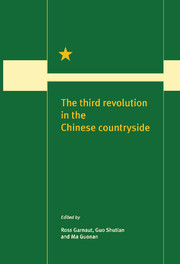Book contents
- Frontmatter
- Contents
- Figures
- Maps
- Tables
- Contributors
- Preface
- 1 The third revolution
- Feeding the people
- Marketing and price reform
- 6 Price reform for agricultural products
- 7 Grain marketing: from plan to market
- 8 Fertiliser price
- 9 Agricultural wholesale markets
- 10 The ‘wool war’ and the ‘cotton chaos’: fibre marketing
- 11 Conflict over cabbages: the reform of wholesale marketing
- Internationalisation
- Regional issues
- Institutional change
- References
- Index
9 - Agricultural wholesale markets
from Marketing and price reform
Published online by Cambridge University Press: 04 August 2010
- Frontmatter
- Contents
- Figures
- Maps
- Tables
- Contributors
- Preface
- 1 The third revolution
- Feeding the people
- Marketing and price reform
- 6 Price reform for agricultural products
- 7 Grain marketing: from plan to market
- 8 Fertiliser price
- 9 Agricultural wholesale markets
- 10 The ‘wool war’ and the ‘cotton chaos’: fibre marketing
- 11 Conflict over cabbages: the reform of wholesale marketing
- Internationalisation
- Regional issues
- Institutional change
- References
- Index
Summary
In what is a new development in Chinese agricultural marketing, many wholesale markets have sprung up since the mid-1980s. The first were for vegetables. In Shangdong, the Shoiguang Vegetable Wholesale Market was set up in a major vegetable producing area in 1984. The first grain wholesale market was opened in Guangzhou in October 1990; the first central meat wholesale market in Chengdu in October 1991; and the first sugar wholesale market in the north of China was established in Tianjin in January 1992.
These markets take two forms. One type formed spontaneously and are administered by the Industrial and Commercial Bureaus. The second type has been established by state commercial organisations. Industrial and Commercial Bureaus were administering nine times as many agricultural wholesale markets in 1992 as in 1983.
The role of wholesale markets
Wholesale markets are an important vehicle for deepening agricultural marketing reform. They provide markets for many commodities that lack them. They coordinate dispersed production with concentrated urban requirements, and seasonal patterns of production with continuous consumption.
The wholesale markets have increased efficiency. In the Taiyuan Hexi Agricultural Wholesale Market, the efficiency of labour is high and costs are low. More than 80 products are traded. The market provides twothirds of the vegetable requirements of nearby urban residents and transacts throughout 24 provinces. The collection of management fees has risen steadily and the market has only 16 administrative employees.
- Type
- Chapter
- Information
- The Third Revolution in the Chinese Countryside , pp. 113 - 119Publisher: Cambridge University PressPrint publication year: 1996

